By Jim Harvey, Lynn Krasnow, Erica Burton, Greg Cailliet, Heather Fulton-Bennett, Ryan Manzer, Alex Olson, Melissa Nehmens, and Heather Kramp
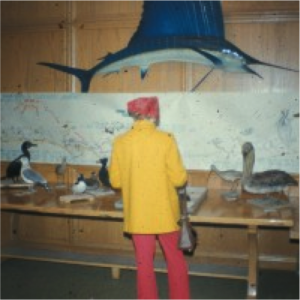

Since the inception of MLML, the students, faculty, and staff have sponsored an Open House. On 29 April 1967, one day after the dedication of Moss Landing Marine Laboratories, 500 people showed up for the first MLML Open House. We have doing it every year since, no matter whether we had a real marine lab (the trailer years) or not. It is one of the great annual MLML traditions. Every year a student committee is formed, plans are devised for who will organize and cook the food, who will be responsible for parking, who will organize speakers or the bake sale, and a group of talented souls (or soles if it is about fish) start the process of developing the puppet show. Most everybody pitches in, and it shows. It truly is a MLML community event. It is remarkable that a research and teaching facility would open its doors so openly that almost all the spaces are on show. In recent years we have had 1,500 to 2,500 of the public attend Open House during a weekend.
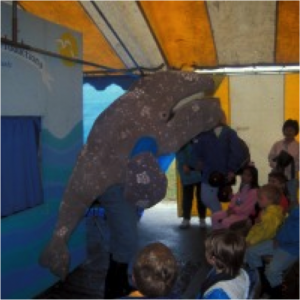
Jim Harvey (1978): Every year the Vertebrate Ecology Lab would put out skulls, skins, baleen, videos of research, posters, and some kid-friendly activity. Some of my favorite activities meant to teach something were: (1) an insulated glove so the kids could stick their hand in ice water and understand what blubber does for a seal or whale; (2) a rake used to collect plastic krill in a bucket so they could visualize how baleen works, or (3) a transmitter on a small dog running around through the building so the kids could practice radio-tracking. The Vert Lab during Open House was pretty much the same for many years until some kid I recognized from the previous year, took a spin through the lab and within a minute exclaimed: “It’s the same as last year”. I was ticked off, so the next year we made a humpback whale head through which you entered into the lab and into the belly of the whale with ribs, entrails, and all. Never saw the kid again.
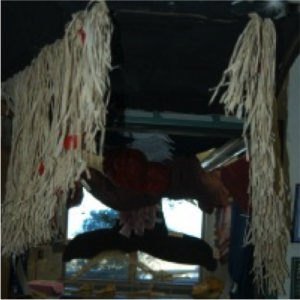
Lynn Krasnow (1978 ): I have my favorite memory from circa mid-1970s. Remember the holding tank outside the old lab? Divers loaded it up with all kinds of inverts and small fish and grabbed things to show people during open house. Monica Farris picked up an Aplysia (sea hare) to show my parents and of course it just sort of collapsed in a gelatinous heap on her hand. My mother said something like "ugh! what purpose does that have?" Monica: "What purpose do you have?" My mother (haughty voice): "I have two children!" And Monica scores the touchdown with "this has millions of children."
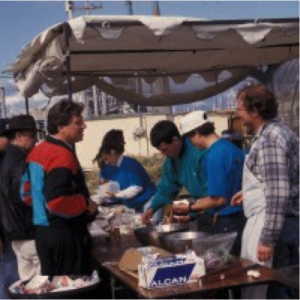
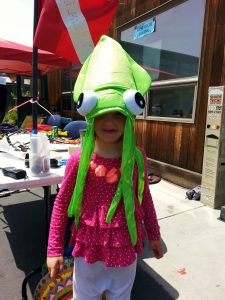
Erica Burton (1999): During the ‘homeless’ years in the Salinas trailers, the thought of an Open House was daunting. “What do you mean we’re having an Open House? We have no House.” It didn’t stop the spirited faculty, staff, and students. As the saying goes, “If you build it, [they] will come.” Large tents were erected, electricity was plumbed, tables and chairs were hauled in, food was prepared in cold, dark, small spaces, exhibits were created, puppets were plumed, and They came. Open House during these years was not only an opportunity to showcase MLML science, but also an opportunity to garner community support for rebuilding the lab near its former location. Bumper stickers, pins, hats, and t-shirts were worn promoting the rebuilding of the lab. And we did.
Greg Cailliet (who knows): Well, I have been involved in so many open houses since I started at MLML in 1972 (even longer than Mike Foster, but not Bill Broenkow) that I cannot count them or recall a whole lot about them. But I do know that the students, staff and faculty work very hard to clean up the facilities and prepare the labs and classrooms with interesting and informative exhibits. The Ichthyology Lab has always been active and is known for years of fish printing for kids, fish identification exercises, and microscope set-ups involving feeding habit analysis, age and growth with bony fish otoliths and elasmobranch vertebrae, and reproduction studies of fishes. More recently, students in the Pacific Shark Research Center have been active displaying sharks and rays. In some years, we have been lucky enough to collect large fishes like Opah, Tuna, Louvar, Bat Ray, Leopard Shark, Spiny Dogfish, Angel Shark, Rattail, Chimaera`, and other interesting fishes – often they were kept on ice and even dissected to show the public morphological adaptations.
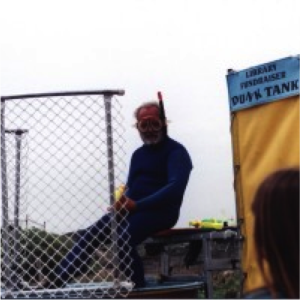
I recall one Open House that we had at the shore, even though we were still in the Salinas Trailer Park facility, in which faculty volunteered to be the target in a dunk tank to raise money for the student body and lab in general. For those us who volunteered, it was quite a shock when those who were interested in dunking us (often students, but others from the faculty, staff and public also joined in) actually hit the spot which forced us to drop down into a cold tank of water. That was when my wet suit still actually fit! It was good, clean fun and even made a few needed bucks.

Heather Fulton-Bennett (current student): While directing parking doesn't sound the most exciting, one of the best parts is flagging down residents and visitors to Moss Landing who otherwise had no idea about Moss Landing Marine Labs. It's great to get someone who may have been in town to fish, antique shop, or eat at Phil's to stop by and learn a little about us and marine science. The Phycology Lab's kelp forest displays fresh intertidal and subtidal seaweeds, allowing visitors to learn about intertidal zonation as well as the wide variety of products seaweeds are used in. One of the highlights for kids is the ice cream table, handed out along with the knowledge that most ice creams are full of seaweed extracts, and no one can taste it at all!
Ryan Manzer (current student): For the past open house my oceanography colleagues and I decided to go all out and some even constructed a mock up of the bow and stern of the recently departed Pt. Sur through which visitors would walk to get into the Oceanography classroom and our exhibits there. For my part, I utilized the Matlab skills I had learned in the MLML Data Modeling class to develop a user interface that presented visitors with a bathymetric map of the Monterey Bay with locations of CTD casts highlighted in addition to a control panel and plotting frame for plotting data.
Users selected the location they were interested from a drop down menu and the variable of interest and clicked the "Start Cast" button. I animated the plotting of the data so that it more accurately reflected what researchers see when making casts in real time. The color schemes and interface style were modeled after the software actually used by the marine science tech on the Pt. Sur. While it seemed a little silly to me when first presenting it, these plots and the questions they prompted from visitors gave a very clear picture of some of the research physical oceanographers do and how it can apply to others.
One of my favorite moments occurred when a sharp eyed visitor spotted an odd feature in the O2 and temperatures plots near the bottom at a couple sites near the canyon and asked us "what is going on there?". After Jason and I puzzled over the plots and referenced some other sample locations we had to admit we didn't know. After a few minutes speculation with the visitor wherein we all suggested potential drivers for the results the visitor left with a much better understanding of how and why we study the ocean.
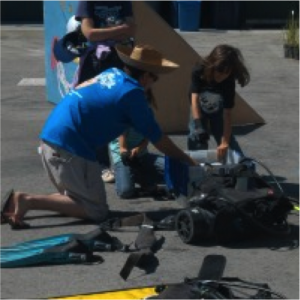
Alex Olson (current student): As a volunteer diver at MLML for Phycology students, I went to an Open House and discovered that there was so much more to this place than algae (Algae are still cool!). I never really thought there could have been so many niche areas of research under one roof. The do-it-yourself wandering tour around the labs inspired and stoked my curiosity. Fast forward to 2014. My first Open House as a student found me staging visitors for a tour of the Pt. Sur at the gate to the dock. While waiting for the next 15 min tour to start, my job was to answer any questions visitors might have and show off the exposure suits that we carried with us on research cruises. Also known as "Gumby" suits, these thick neoprene suits are designed to keep the inhabitant warm and dry whilst floating in the water and awaiting rescue after abandoning ship. It being a warm sunny day I didn't think about actually getting into the suit, but just refer to it in my spiel about the ship and how great MLML was. The suits were unfurled on the hot cement, arms out, almost like crime scene chalk drawings. Sure enough, someone in the first group asked how they exactly work and if I could demonstrate.
You know that guy who holds the door open for someone, but gets stuck standing there for everyone else filing through?
I was that guy....with a Gumby suit.
I kicked off my shoes, slid in legs first, and scooted on my butt until I got waist deep. Then I stood up, put my left arm in the sleeve, pulled on the hood, slipped in my right arm, and pulled the zipper up until only my eyes and nose were visible. Ta daaah! "That, folks, is how you get into a Gumby suit!"
The whole day was a repeat of that first group. Visitors slowly trickled in, asking for demonstrations, to the point where I was just getting into the suit whenever a new gaggle of people came by. I must have jumped in and out of those suits at least 20-25 times. I was a borderline sweaty mess, quietly hoping for some cloud cover or an end to the stream of visitors. It was only in the second half of the day when I had a small stroke of genius, realizing I wasn't the only body standing on the cement dock. I supervised suit donning for a variety of sized people, some disappearing in the suit, others turning the same red suit color as they pushed the seams to their limit.
It was a truly rewarding experience. Not only did I lose a few pounds of water weight by the end of the day, but the people's fascination of the lab, its ship and even the comfy Gumby suits, was a validation of my return to this place as a student.

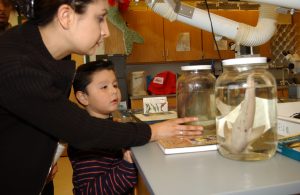
Melissa Nehmens (current student): One little girl sticks out in my mind because she was rather comfortable with the idea of “sleeping for a long time,” which her father mentioned was to be attributed to Disney’s Sleeping Beauty. In her questioning about the shark embryo that she was holding in a jar filled with ethanol, we seemed to have a persistent disagreement as to whether or not the baby, as she called it, would ever wake up. A rather large disconnect in the implied meaning versus explicit meaning of “sleeping forever” seemed to be our hang up, which I only realized after some time. A circular conversation of why’s from the little girl and tip-toed answers from myself really emphasizing the forever part of sleeping seemed to be going nowhere. The parents looked on with smiles, slyly laughing to themselves at my discomfort, and finally gave me a nod to deliver the truth. It was met with a simple “oh” and a furrowed brow, followed by another question which I could see her formulating on her face. “So the baby isn’t going to wake up?” I replied with a no, and from there a new line of questioning began. It was the best conversation I have ever had with a three year old.
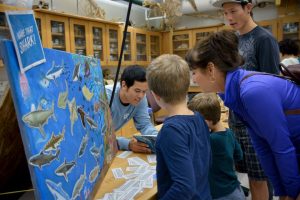
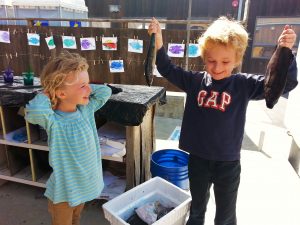
Heather Kramp (current student): For the past three years I've set up the most beloved, and most dreaded, activity in the Ichthyology lab, fish printing. We repurpose class research cruise specimens and left over thesis samples as art. A table in the corp yard and kids get to pick out a real, dead fish from a cooler. My favorite part of this experience is letting kids know they can pick up the fish and watching their reaction. Most kids are thrilled. Most parents are not quite as thrilled. Next, kids slather on some paint and press a piece of paper on top. The paper is peeled back and, hopefully, a nice impression of the fish is left behind. Kids ask so many questions about where the fish come from and what they eat. Lots of fish "petting" occurs and so many fish eyeballs are poked. My favorite kids are the serious painters. They take their time with every brush stroke and really get into their masterpiece. For the few kids that don't want to touch real fish, rubber ones are available because everybody loves to paint. Rows of fish prints dry on clothesline all weekend long. Kids just love fish printing. But, standing in the hot sun and trying to manage five little painters at once can be a huge challenge. Kids have to be gently encouraged that much, much less paint makes for a better print. Each year at least a handful of pint-sized Jackson Pollock impersonators show up. By early afternoon paint colors have been mixed together and the fish are gooey. First year students often walk away shell-shocked after a couple hours at the table. When the last guests leave we're exhausted. But, there's usually enough energy left for us to do some fish printing of our own. Student works of art adorn the Ichthyology lab walls year-round.


